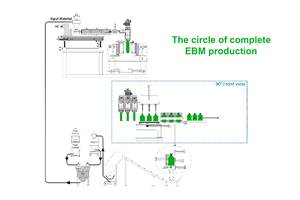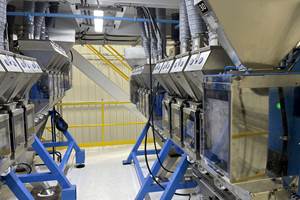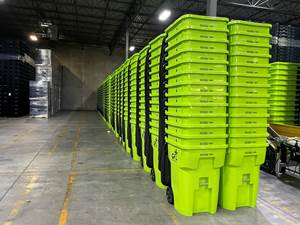The Fine Art Of Separation
If you need ground plastic waste separated from metal particles, or plastic flakes separated by color or density, Butler-MacDonald Inc. is up to the job.
If you need ground plastic waste separated from metal particles, or plastic flakes separated by color or density, Butler-MacDonald Inc. is up to the job. If your problem is to separate different plastics of the same color and density, this Indianapolis recycler can do that, too.
Very few recyclers can match such comprehensive automated separation capabilities. But it wasn’t always that way for Butler. In the late 1980s, Butler reclaimed metals for big utility companies. Along with scrapped switches, cables, and telephones came discarded central-office computers and other electronics. So the firm had to deal with more and more plastics.
Company founder J.D. Johnson was convinced there was value in those plastics, notably ABS. By 1990, Butler-MacDonald built its first equipment to recover plastics, a float/sink system that was rudimentary but automated. Automation distinguished it from the firm’s highly labor-intensive metal recovery. Butler had 150 employees and 450,000 sq ft of disassembly space in three locations.
Johnson had read about the use of hydrocyclones in the mining industry to separate tailings. So he bought some small cyclones and began to experiment with separating ABS from metal. The first small cyclones worked much better than the float/sink system, but the volume of telephone scrap was escalating. Butler would need more cyclones to keep up.
Hold the phone
At that point in 1993, AT&T offered Butler a contract to become its sole customer. AT&T wanted Butler to build a new plant in Mexico to use cheaper labor. The recycler, however, looked at its changing feed stream. “We could see that as more plastics came in, we would need more automation and less hand work,” recalls Butler president Scott Johnson, the founder’s son. “So we went back to AT&T and asked if they would listen to what we thought they needed.”
By 1995 Butler had built a big new automated plant based on hydrocyclones exclusively for AT&T. It could reclaim 50 million lb/yr of metals and 20 million lb/yr of ABS, PS, PC, PC/ABS, and PP. About 10 million lb/yr of ABS alone were recovered and sold by AT&T to compounders.
In 1998, Butler was still mainly reclaiming metal and was virtually captive to AT&T. Then AT&T split off its equipment manufacturing operations as Lucent Technologies. Butler’s recycling contract was assigned to Lucent, but Lucent, now divorced from AT&T’s phone installation business, didn’t generate much scrap. So Lucent and Butler agreed to end the contract.Plunging into plastics
Butler-MacDonald once again had to reinvent itself, switching from mostly metals to all-plastics reclaiming. It also changed from a one-account company that didn’t buy or sell anything to a toll plastics reclaimer with multiple sources and customers for its reclaimed plastics. New business included disposable cameras.
Sourcing new suppliers and customers to replace AT&T wasn’t easy. Many customers for toll plastics remediation call only when they’ve had an accident, like blowing the wrong resin into a silo. Convincing first-time customers of Butler’s high-purity separation capabilities was also hard, Johnson says, because some processors had prior bad experiences with toll grinding and separation.
“Hydrocycloning is an art form,” Johnson asserts. “How well you get two densities to separate translates into the purity levels you get. We usually quote 99.9% purity, but there are lots of times when we achieve 100%.”
The company spent $750,000 to reconfigure its plant to separate a variety of polymers, both by color and density. Hydrocyclones would remain the mainstay of its new custom plastics separation business, but the plant had to be able to change polymer feed streams quickly. Where once Butler had a steady diet of telephones, it now rarely runs one feed stream for more than two or three days at a time.
Butler installed new size-reduction equipment, rare-earth magnets, ferrous and nonferrous metal detectors, color-separation equipment (from Satake USA Inc. in Houston), aspirators to remove paper and cardboard, and washing and rinsing equipment.
In February, Butler installed the first electrostatic separation equipment in the U.S. from Hamos GmbH in Germany (represented here by Progressive Design, Ft. Wayne, Ind.). This made it possible to separate plastics of the same color and density, such as PS and ABS or flexible and rigid PVC. Later this year, Butler will install a cryogenic size-reduction system to turn scrap PVC back into powder.
Related Content
Get Color Changes Right In Extrusion Blow Molding
Follow these best practices to minimize loss of time, material and labor during color changes in molding containers from bottles to jerrycans. The authors explore what this means for each step of the process, from raw-material infeed to handling and reprocessing tails and trim.
Read MoreTosaf’s Investments in North America Result in 40% Increase in Production Capacity
Backed by a global presence, Tosaf provides localized additive and color solutions, and services for the plastic industry in North America.
Read MoreNovel System Produces Color on Demand
Ampacet’s FluxQF technology features a quick-dispersion universal carrier with novel machinery that provides automated color blending in quantities down to 50 lb.
Read MoreInjection Molder Changes Up Color Changes
An injection molder of trash cans, pallets, totes and other plus-size components, Rehrig Pacific’s machine fleet is composed of larger tonnage presses whose size makes material changes at the feed throat a potentially dizzying exercise.
Read MoreRead Next
Why (and What) You Need to Dry
Other than polyolefins, almost every other polymer exhibits some level of polarity and therefore can absorb a certain amount of moisture from the atmosphere. Here’s a look at some of these materials, and what needs to be done to dry them.
Read MoreUnderstanding Melting in Single-Screw Extruders
You can better visualize the melting process by “flipping” the observation point so that the barrel appears to be turning clockwise around a stationary screw.
Read More























